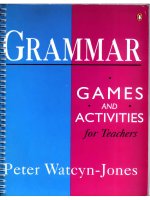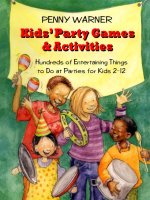Games and activities for students
Bạn đang xem bản rút gọn của tài liệu. Xem và tải ngay bản đầy đủ của tài liệu tại đây (176.41 KB, 12 trang )
GAMES AND ACTIVITIES FOR
STUDENTS
CATCHING UP ON YOUR ABC'S
Level: Any Level
This game is short and simple. Write the alphabet on the
board. Throw a bean bag to someone and say a word
begining with the letter A. This person must catch the bean
bag, say a word begining with the letter B and then throw it
to another person This third person says a word begining
with the leter C and so on.
Obviously the game is meant to be played fast. If played
with higher level students you may not want to write the
alphabet on the board. There are many ways to change the
game to make it adaptable to your level of students.
SECRET CODE
Level: Any Level
I sometimes give instructions to my students written in code that they have to
interpret before completing tasks. I've used this at various levels:
Here's an example: to revise alphabet and simple present verbs/vocab.
Tell students the code e.g. each code letter represents the letter that comes before
it in the alphabet a is b, m is n, 'dbu' is cat etc.
Then they decode their message and do the task:
xbml up uif cpbse - walk to the board
kvnq ufo ujnft - jump ten times
To make it more difficult, I've ...used more complex codes,
let them work the code out for themselves,
have not defined where words end,
have given more complicated tasks or vocabulary
or given them half an instruction which they must decode and then find the
classmate with the other half of their task information.
This activity can be used to review or practise vocabulary or structure or simply be
a different way to introduce the topic for the day's class -- each student gets one or
two words to decode and then the class work to put all the words together.
CAN YOU FIND WHAT IS DIFFERENT?
Level: Easy
Ask a volunteer to go out of the classroom. While the
student is out of the room, the other students change their
sweaters, shoes, coats and so on. Bring the student who
went out of the classroom back inside. He/she has to guess
the differences (speaking in English, of course.)
REVIEWING TENSES
Level: Any Level
Preparation:
Print out three sentences (negative, positive, and question) of the tense you want to
review.
Cut each sentence into words.
The Activity:
Students work in groups.
Give each group of students words of a sentence and ask them to make the sentence.
Draw a table on the board and ask students to tick sentences at suitable positiions,
positive, negative, or question.
Ask students to make rules of the tense.
Example: Three Sentences:
I am a student.
I am not a student.
Are you a student?
The Rules:
TO BE at the present simple
ALPHABET LIAR GAME
Level: Any Level
Take a pack of letter cards, mixed up. It is better if it is not a complete
alphabet, and there are some duplicate cards.
Deal all the cards out to the players
Students take it in turns to play cards face down. They must go through the
alphabet, starting from 'A', playing one card face down and saying the
letters in Alphabetical order.
Even if they do not have the card to be played for that turn, they must play
any card and pretend it is the card they said. Say the sequence has gone
A,B. The next player must play a card and say C, even if he has not got an C.
If any player does not believe that someone has played the real card, he can
say: "You're a liar" and turns the card over. If the card has the letter which
was said, the challenger picks up all the cards. If it is not, the liar picks up
all the cards in the pile. The winner is the first one to finish all their cards.
SURVIVOR SPELLING GAME
Level: Any Level
Use this activity to review vocabulary:
Make a list of vocabulary covered in previous lessons. Have students
stand. Call out a vocabulary word. The first student begins by saying
the word and giving the first letter, the second student the second
letter of the word, the third student the third letter, and so on until
the word is spelled correctly. If somebody makes a mistake they must
sit down and we start from the beginning again until the word is
spelled correctly. The last student must then pronounce the word
correctly and give a definition in order to stay standing. The student
who is left standing is the "survivor" and wins the game. I usually
give them some type of prize. If all the students remain standing we
have a pizza party at the end of the week.
The students love it and it is a great way to practise vocabulary!!!
WHAT'S YOUR NAME?
Level: Easy (Raw beginners)
One student sits in the front of the classroom (usually in the teacher's
comfortable chair) with his back to the other students. The teacher then
points to students in the class and asks "What's your name?" The
student indicated must respond "My name is__________" with either his
own name or the name of someone in the class. The student in the front
cannot see who is speaking. The teacher says to him, "Is it___________?"
and he must say "Yes, it is" or "No, it isn't". If the student in front is
correct, he gets to stay there, but if he's mistaken, he changes place
with the student who fooled him.
To make the game more interesting, the students are encouraged to
disguise their voices.
I always do this with my beginners at the beginning of the year, but
always at the end of the class, and for not more than 5 to 10 minutes.
(My beginners are elementary age.)
BALL GAME
Level: Any Level
Students stand up in a circle around the teacher. A ball is
tossed to a student and the teacher asks a question, e.g.:
"Say a color". The student then responds and throws the ball
back to the teacher. The teacher then throws the ball to
another student and asks another question. For higher
levels, you can ask such questions like "Give me the past
participle of an irregular verb". This is a fast game, and it is
great for reviewing vocabulary.
Submitted by: Ashraf Abu Ghazal
DRAW THE TEACHER
Level: Any Level
This game helps to teach children the names of facial parts.
Divide the class into two teams. Then draw 2 ovals shapes on the board. Then
yell "Draw the teacher's eyes!" and the two leading students from each team
run up and draw your eyes on the oval. Then yell "Nose!" which is drawn by the
next two students. And so it goes. The student get a ball out of this as they
have permission to make fun of their teacher, and your image can get to look
pretty distorted. You can add other features, such as nose or ear hairs. This will
also work if you want to do body parts as well. Just draw the basic torso instead
of ovals.
If the kids are unsure as to which facial/body part you're talking about, just
point to it.
At the end say both images look pretty good and call it a tie.
Another variation on this could be for naming parts of animals. The resulting
picture would be a monster. i.e. peacock's tail, snake's head, elephant feet,
bat's wings, etc.
PREPOSITIONS GAME
Level: Medium to Difficult
Prepare a text that contains prepositions. Take out the
propositions and print them on a separate sheet, then cut
this sheet so that each preposition is on a piece of paper,
then put all of them in an envelope . Divide the class into
groups and give each group an envelope. Tell the students
that you are going to read a text and whenever you raise
your hand they should bring a suitable preposition and put it
on your desk and that the fastest team would get points.
Read the text with each groups' order and cancel a point for
each mistake. Finally read the text with correct prepositions.
You can play this game with adj as well as a,the and an.
AIR WRITE
Level: Any Level
One person "writes" letters, words, numbers, shapes etc: in
the air and others guess what it is. Can be done in pairs, as
a group, along a chain.
Can also be played as back-write, that is, writing the
letter/word/... on the back of another and they guess what it
is.









